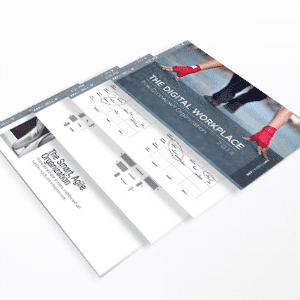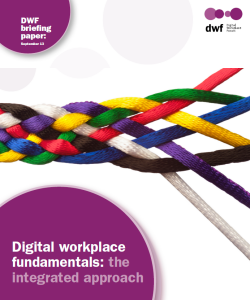Review of Jane McConnell’s 2014 “Digital Workplace Trends” report
Now in its eighth year, Jane McConnell’s annual publication about the state of the digital workplace in the enterprise is a key piece of research in the field of workplace technology. Based on a detailed survey completed by over 300 organizations, it gives a complete and authoritative view of what is happening regarding multiple aspects of the digital workplace.
A compelling look at the state of the digital workplace
 The 2014 report, titled “The Digital Workplace in the Connected Organization”, is possibly the most insightful edition yet. There is a great amount of detail to digest in its 184 pages covering many themes, from mobility to BYOD to leadership communication.
The 2014 report, titled “The Digital Workplace in the Connected Organization”, is possibly the most insightful edition yet. There is a great amount of detail to digest in its 184 pages covering many themes, from mobility to BYOD to leadership communication.
Anybody considering future digital workplace strategy or wanting to move forward in particular areas will gain a perspective on seeing where other organizations are on their digital journey, both in an overall sense and for more specific themes. There is also a regular comparison between how most organizations and “early adopters” are faring.
This year’s report
McConnell’s survey is rooted in enterprise intranets, but has now completely transitioned into the wider themes of the digital workplace. Last year’s report was the first to be presented in a different format – i.e. landscape, with every page a potential slide in a presentation – as well as introducing some case studies. This year the format has again morphed slightly. For example there is a more extensive summary overview and commentary for each chapter and the case studies are more detailed.
Another major addition this year is a new “scorecard” which charts nine aspects of the digital workplace, such as leadership, culture, process and structure, against a five-level scale of maturity – from “ad hoc/ unmanaged” to “embedded / proactive”. This is designed to help organizations think about where they are on their own digital workplace journey, and can act as a self-diagnosis tool. There are also some very handy sector scorecard averages. (Professional services and TMT seem to be the most advanced, by the way.)
McConnell’s framework for her scorecard differs from DWG’s own Digital Workplace Map – for example it tends to focus more on organizational “mindset” (culture, leadership) – but both make a contribution to getting organizations to think far more holistically about digital working.
In looking at the results, there are many interesting points to reference here, but some of the ones that stood out for me are as follows.
This journey is just beginning
In the executive summary McConnell concludes that no organizations, not even the early adopters, have a really effective digital workplace that can be considered to be fully embedded within the enterprise. This would definitely echo with our observation that, although some of the technologies have been around for a while, we’re still in the early stages of really understanding how to use them optimally across the entire workforce.
We need to go way beyond aiming for efficiency
In her executive summary McConnell concludes that: “’Organizational intelligence is the number one strategy driver for Early Adopters whereas ‘efficiency and cost savings’ is number one for the majority.”
I think this is a very interesting observation, and shows how the more adventurous and digitally mature companies are starting to see their technology drive competitive advantage rather than just process improvement. I suspect there are a number of reasons for this, including the fact that efficiency is an easier sell into senior management to get the tools implemented in the first place, but you clearly need to go far beyond cost savings as a strategic driver to achieve the type of organizational transformation that the digital workplace promises.
Mobile is accelerating
Our anecdotal evidence from talking to DWG members is that enterprise mobility is now high on the agenda. In a recent internal member survey it was the most frequently mentioned digital strategic objective for the coming year. Jane McConnell’s own research confirms this – with a prediction that 30% to 40% of organizations will be providing mobile services for the workforce by the end of 2014. McConnell also finds that more organizations are being forced to at least accept BYOD, even if they don’t encourage it.
Enterprise search and information management are still woefully neglected
They’re traditionally difficult areas, but McConnell’s survey finds surprisingly low numbers of organizations consider themselves to have a structured or successful approach to either information management or enterprise search. Given that these disciplines have been around for many years, and that digital work activity is on the rise, it is slightly mystifying that not more is being done to remedy this.
Conclusion
If you’re serious about your digital workplace journey then it’s definitely worth spending time reading “The Digital Workplace in the Connected Organization”. It can help you to reflect where your organization is currently and where it is heading, as well as help start conversations with stakeholders. The information it contains also contributes to our wider understanding of the digital workplace. For more information on obtaining a copy please visit: http://www.digital-workplace-trends.com/.
Related research
Digital workplace fundamentals – an integrated approach
 This report suggests a blueprint for launching a successful digital workplace initiative anchored on two key prerequisites, namely scope (what is included) and approach (how it is delivered).
This report suggests a blueprint for launching a successful digital workplace initiative anchored on two key prerequisites, namely scope (what is included) and approach (how it is delivered).
Among the key takeaways highlighted in this report are 1) the digital workplace permeates all aspects of working life, 2) it affects technology, physical workplaces and people, and 3) cross-functional teams increase the chances of a project successfully meeting its outcomes.
Categorised in: Digital workplace, Digital workplace strategy, Digital workplace trends
